
HPU2. Nat. Sci. Tech. Vol 03, issue 01 (2024), 64-77
HPU2 Journal of Sciences:
Natural Sciences and Technology
journal homepage: https://sj.hpu2.edu.vn
Article type: Research article
Received date: 01-12-2023 ; Revised date: 06-02-2024 ; Accepted date: 04-03-2024
This is licensed under the CC BY-NC 4.0
64
Solvability Analysis of high-order Linear Differential-Algebraic
Equations with time-varying coefficients
Ha-Phi*
Hanoi University of Science and Technology, Hanoi, Vietnam
Abstract
In this paper, we study the solvability analysis of arbitrarily high-order linear differential-algebraic
equations (DAEs) with time-varying coefficients, using the algebraic-behavior approach. We propose
a concept of strangeness-index and construct condensed forms for high-order linear DAEs. We also
discuss other structural properties like the existence and uniqueness of a solution, consistency and
smoothness requirements for an initial vector and for an inhomogeneity. Our work extends the
algebraic approach for DAEs and combines this approach with the behavior approach to establish a
reformulation algorithm that reveals an underlying ordinary differential equation (ODE) and all hidden
constraints in the DAE. This direct treatment of the system addresses the limitations of the classical
approach to transforming the system into a first-order DAE. We illustrate our theoretical results with
applications in mechanical systems and electrical circuits. This comprehensive study into general
high-order systems is a natural progression from the extensive study of first and second-order DAEs.
Keywords: Differential-algebraic equation, strangeness-index, regularization, index reduction
1. Introduction
In this paper, we delve into the solvability analysis of high-order linear differential-algebraic
equations (DAEs) represented by the general form:
𝐴𝑘(𝑡)𝑥(𝑘)(𝑡)+⋯+𝐴1(𝑡)𝑥(𝑡)+𝐴0(𝑡)x(𝑡)=f(𝑡), (1)
on the time interval 𝑡∈𝕀=[𝑡0,𝑡𝑓)⊂ℝ, where 𝐴𝑖∈𝐶(𝕀,𝐶ℓ,𝑛), 𝑖=1,…,𝑘, and 𝑓:𝕀→ℂℓ. To ensure
a unique solution for this equation, an initial function is required:
𝑥(𝑘−1)(𝑡0)=𝑥0(𝑘−1),…,𝑥(𝑡0)=𝑥0, 𝑥(𝑡0)=𝑥0. (2)
* Corresponding author, E-mail: phi.ha@hust.edu.vn
https://doi.org/10.56764/hpu2.jos.2024.3.1.64-77

HPU2. Nat. Sci. Tech. 2024, 3(1), 64-77
https://sj.hpu2.edu.vn 65
While first-order DAEs (𝑘=1) have been extensively studied over the past three decades with
well-established theoretical and numerical results [1]–[3], second-order DAEs (𝑘=2) have found
applications in diverse fields such as constrained mechanical systems [4], electrical and electro-
mechanical systems [5], [6], heterogeneous systems [7], and traveling waves [8], [9], etc. Recently, the
analysis and control of second-order discrete-time system has been considered in [10], [11].
Consequently, a comprehensive investigation into the general high-order system (1) is a natural
progression.
Despite some exploration of specific cases (𝑘=1,2), limited results exist for the general case,
and the classical approach of transforming (1) into a first-order DAE through variable introduction has
shown several critical drawbacks [12]–[16]. These include excessive smoothness requirements on the
inhomogeneity or numerical method failures in a linearized system. Consequently, a direct treatment
of system (1) becomes imperative, forming the central objective of this paper. We adopt a unique
perspective by extending the algebraic approach for DAEs proposed in previous works [3], [17] and
combining it with the behavior approach [18]. The goal is to establish a reformulation algorithm that
unveils an underlying ordinary differential equation (ODE) and all hidden constraints in the DAE (1).
The paper is organized as follows. Section 2 introduces necessary notations and auxiliary lemmas.
In Section 3, we extend the concept of the strangeness-index, initially designed for first-order systems,
to the high-order system (1). Additionally, we devise a reformulation algorithm to transform (1) into
its strangeness-free form. This section also addresses the solvability analysis of the initial value
problem consisting of (1)–(2). Finally, Section 4 illustrates our results through examples in the fields
of mechanics and electrical circuits.
2. Preliminaries
In this paper we use the following solution concept for (1).
Definition 1. A function 𝑥:𝕀→ℂ𝑛 is called
i) a (classical) solution to (1) if 𝑥∈𝐶𝑘(𝕀,ℂ𝑛) and 𝑥 satisfies (1) pointwise.
ii) a (classical) solution to the initial value problem (1)-(2) if 𝑥 is a solution of (1) and satisfies
(2).
We introduce 𝑋0:=[𝑥0(𝑘−1),𝑇 ... 𝑥1𝑇 𝑥0𝑇]𝑇∈ℂ𝑘𝑛 as an initial vector of the initial value problem
consisting of (1) and (2).
iii) An initial vector 𝑋0 is called consistent to system (1) if the initial value problem (1)–(2) has a
solution.
iv) System (1) is called solvable if for every sufficiently smooth 𝑓 and every consistent initial
vector 𝑋0, the associated initial value problem (1)–(2) has at least one solution. It is called regular if it
is solvable and the solution is unique.
We recall without proof the following results, see e. g., Theorems 3.9, 3.25 ([3]) .
Theorem 2 ([3]). Let 𝐸∈𝐶ℓ(𝕀,ℝ𝑚,𝑛), ℓ∈ℕ0∪∞, with rank𝐸(𝑡)=𝑟 for all 𝑡∈𝕀. Then there
exist pointwise unitary functions 𝑈∈𝐶ℓ(𝕀,ℂ𝑚,𝑚) and 𝑉∈𝐶(𝕀,ℂ𝑛,𝑛), such that 𝑈𝐻𝐸𝑉=[𝛴𝐸0
0 0],
with pointwise nonsingular 𝛴∈𝐶ℓ(𝕀,ℂ𝑟,𝑟).

HPU2. Nat. Sci. Tech. 2024, 3(1), 64-77
https://sj.hpu2.edu.vn 66
Theorem 3 ([3]). Let 𝕀⊂ℝ be a close interval and 𝑀∈𝐶(𝕀,ℂ𝑚,𝑛). Then there exist open
intervals 𝕀𝑗⊂𝕀, 𝑗∈ℕ, with ⋃𝕀𝑗𝑗∈ℕ =𝕀,𝕀𝑖∩𝕀𝑗=∅ for 𝑖≠𝑗, and 𝑟𝑗∈ℕ0, 𝑗∈ℕ such that
rank 𝑀(𝑡)=𝑟𝑗 for all 𝑡∈𝕀𝑗.
Making use of this theorem, in the remaining part of this research, we can assume constant rank
assumptions holds, in particular in Algorithm 13.
For two functions 𝑃∈𝐶(𝕀,ℂ𝑝,𝑛), 𝑄∈𝐶(𝕀,ℂ𝑞,𝑛), the function pair (𝑃,𝑄) is said to have no
hidden redundancy if rank([𝑃(𝑡)
𝑄(𝑡)])=rank(𝑃(𝑡))+rank(𝑄(𝑡)) for all 𝑡∈𝕀.
The following lemmas are taken from [17].
Lemma 4 ([17]). Suppose that for 𝑃∈𝐶(𝕀,ℂ𝑝,𝑛), 𝑄∈𝐶(𝕀,ℂ𝑞,𝑛), the function pair (𝑃,𝑄) has
no hidden redundancy. Let 𝑈∈𝐶(𝕀,𝐶𝑞,𝑞) and 𝑉∈𝐶(𝕀,𝐶𝑝,𝑝) be two arbitrary functions. Then, the
function pair (𝑈𝑃,𝑉𝑄) has no hidden redundancy.
If for all 𝑡∈𝕀, matrix [𝑃(𝑡)
𝑄(𝑡)] is of full row rank then obviously, the function pair (𝑃,𝑄) has no
hidden redundancy. However, the converse is not true as is obvious for 𝑄=[1 0
0 0], 𝑃=[0 1
0 0],
since (𝑃,𝑄) has no hidden redundancy, but [𝑄
𝑃] does not have full row rank.
Lemma 5 ([17]). Given two functions 𝑃∈𝐶(𝕀,ℂ𝑝,𝑛), 𝑄∈𝐶(𝕀,ℂ𝑞,𝑛). Moreover, assume that 𝑃
has pointwise full row rank, and rank(𝑄), rank([𝑃
𝑄]) are constants on 𝕀, i. e., rank(𝑄(𝑡))=𝑞1,
rank([𝑃(𝑡)
𝑄(𝑡)])=𝑞2 for all 𝑡∈𝕀. Then, there exists a function [𝑆 0
𝑍1𝑍2]∈𝐶(𝕀,ℂ𝑝+𝑞) such that the
following conditions hold.
i) [𝑆
𝑍1]∈𝐶(𝕀,ℂ𝑝,𝑝) is pointwise unitary,
ii) [𝑍1𝑍2][𝑃
𝑄]=0,
iii) the function pair (𝑆𝑃,𝑄) has no hidden redundancy.
Lemma 6. Consider 𝑘+1 pointwise full row rank functions 𝑅0∈𝐶(𝕀,ℂ𝑟0,𝑛), …, 𝑅𝑘∈
𝐶(𝕀,ℂ𝑟𝑘,𝑛), such that none of the function pairs (𝑅𝑗(𝑡),[𝑅𝑗−1
𝑇(𝑡)… 𝑅0𝑇(𝑡)]𝑇), 𝑗=𝑘,…,1 has a
hidden redundancy. Then, [𝑅𝑘𝑇(𝑡)… 𝑅0𝑇(𝑡)]𝑇 has full row rank for all 𝑡∈𝕀.
Proof. The proof is straightly followed by induction, i.e.,
𝑟𝑎𝑛𝑘([𝑅𝑘
𝑅𝑘−1
⋮
𝑅0])= 𝑟𝑎𝑛𝑘(𝑅𝑘)+𝑟𝑎𝑛𝑘([𝑅𝑘−1
⋮
𝑅0])= 𝑟𝑎𝑛𝑘(𝑅𝑘)+𝑟𝑎𝑛𝑘(𝑅𝑘−1)+𝑟𝑎𝑛𝑘([𝑅𝑘−2
⋮
𝑅0]),
= ... =rank(𝑅𝑘)+rank(𝑅𝑘−1)+⋯+rank(𝑅0),
and since 𝑅𝑘,…,𝑅0 have pointwise full row rank, then [𝑅𝑘𝑇… 𝑅0𝑇]𝑇 has pointwise full row
rank. ◻

HPU2. Nat. Sci. Tech. 2024, 3(1), 64-77
https://sj.hpu2.edu.vn 67
3. Strangeness-index concept and strangeness-free form of high-order DAEs
As stated in the introduction, this section is devoted to a strangeness-index concept and a
reformulation algorithm of the high-order linear DAE (1). See also [14]–[16] and the references
therein for previous works on this topic. Note that different from previous investigations, we study
system (1) by extending the algebraic approach for first order DAEs proposed in [3], [17] and
combining with the behavior approach [18]. Let
𝑀(𝑡):=[𝐴𝑘(𝑡)⋯𝐴0(𝑡)] and 𝑋(𝑡):=[𝑥(𝑘)(𝑡)
⋮
𝑥(𝑡)], 𝑡∈𝕀, 𝑋0:=[𝑥(𝑘−1)(𝑡0)
⋮
𝑥(𝑡0)]. (3)
Then 𝑀(𝑡) (resp., 𝑋(𝑡)) is called the behavior function (resp., behavior vector) of IVP (1)-(2),
which can be rewritten as
𝑀(𝑡)𝑋(𝑡)=𝑓(𝑡) for all 𝑡∈𝕀, 𝑋(𝑡0)=𝑋0. (4)
Hypothesis 7. Denote by
𝑚𝑖(𝑡):=rank([𝐴𝑘(𝑡),…,𝐴𝑘−𝑖(𝑡)]), 𝑖=0,…,𝑘,
we assume that functions 𝐴𝑖, 𝑖=0,…,𝑘 of system (1) fulfill the following constant rank
conditions 𝑚𝑖(𝑡)≡𝑚𝑖 for all 𝑡∈𝕀, 𝑖=0,…,𝑘.
Under the Hypothesis 7, we can transform 𝑀 to the block diagonal form as in the following
lemma.
Lemma 8. Consider the behavior function 𝑀 of system (1). Moreover, suppose that Hypothesis 7
holds. Then, there exists a pointwise nonsingular function 𝑃∈𝐶(𝕀,ℂℓ,ℓ) such that
𝑀
:=𝑃𝑀=
[
𝐴𝑘,1 | 𝐴𝑘−1,1 | … | 𝐴0,1
| 𝐴𝑘−1,2 | … | 𝐴0,2
| | ⋱ | ⋮
| | | 𝐴0,𝑘+1
0 | 0 | … | 0
]
, 𝑟1
𝑟2
⋮
𝑟𝑘+1
𝑣 (5)
where every function 𝐴𝑗,𝑘+1−𝑗, 𝑘≥𝑗≥0 on the main diagonal has pointwise full row rank.
Moreover, those ranks are computed via
1 0 2 1 0 1 -1
, - ,..., - , - .
k k k k
r m r m m r m m v m
+
= = = =
(6)
Proof. First, due to Theorem 2, we can find a pointwise nonsingular function 𝑃1∈𝐶(𝕀,ℂℓ,ℓ) such
that 𝑃1𝑀=[𝐴𝑘,1 | 𝐴𝑘−1,1 … 𝐴0,1
0 | 𝐴𝑘−1,2 … 𝐴0,2], 𝑟1
ℓ−𝑟1
and 𝐴𝑘,1 has pointwise full row rank. Moreover, since
rank(𝑃1[𝐴𝑘, 𝐴𝑘−1])=rank([𝐴𝑘,1 𝐴𝑘−1,1
0 𝐴𝑘−1,2])=𝑚1, for all 𝑡∈𝕀,
it follows that rank(𝐴𝑘−1,2(𝑡))=𝑚1−𝑚0=:𝑟2 for all 𝑡∈𝕀. Thus, using Theorem 2 again, we
compress the 2nd block column from the second block row of 𝑃1𝑀 and then inductively for the other
columns of 𝑀, we determine a sequence of pointwise nonsingular functions 𝑃𝑖, 1≤𝑖≤𝑘+1 such

HPU2. Nat. Sci. Tech. 2024, 3(1), 64-77
https://sj.hpu2.edu.vn 68
that 𝑃:=∏𝑃𝑖
𝑖=𝑘+1
1 and 𝑃𝑀 takes the block diagonal form (5). Furthermore, (6) follows directly from
the construction of 𝑃. ◻
We call the number 𝑟𝑢:=(𝑘+1)𝑟1+𝑘𝑟2+⋯+2𝑟𝑘+𝑟𝑘+1 the upper rank of the behavior
function 𝑀. Note, that some of the 𝑟𝑖 may be zero while the corresponding block row is not present.
In the following, without loss of generality, we assume that the behavior function 𝑀 is already in
the form 𝑀
. For notational convenience, we omit the variable 𝑡 in 𝑥, 𝑓 and their derivatives, and also
in all matrix-valued functions. Rewriting system (4) block row-wise, we obtain the system
−
−
−
−
++
+
+ + + +
+ + +
( ) ( 1)
,1 1,1 1,1 0,1 1
( 1)
1,2 1,2 0,2 2
0, 1 1
2
=,
=,
...
=,
0 = .
kk
kk
k
k
kk
k
A x A x A x A x f
A x A x A x f
A x f
f
(7)
Recall that the diagonal blocks 𝐴𝑘,1, 𝐴𝑘−1,2,…,𝐴0,𝑘+1 have pointwise full row rank, therefore in
system (7), for every 𝑗 with 𝑘≥𝑗≥0, the (𝑘+1−𝑗)-th block row
𝐴𝑗,𝑘+1−𝑗𝑥(𝑗)+⋯+𝐴0,𝑘+1−𝑗𝑥=𝑓𝑘+1−𝑗,
represents 𝑟𝑘+1−𝑗=rank(𝐴𝑗,𝑘+1−𝑗) scalar differential equations of order 𝑗. We apply the
algebraic approach to reduce the number of scalar differential equations of order 𝑗, i. e., by using
differential equations of order smaller than 𝑗 and their derivatives.
Let us illustrate this idea for the case 𝑗=𝑘 in the Lemma 9 below. For notational convenience, by
𝐿(𝑥,…,𝑥(𝑗)) we denote an unspecified linear function of 𝑥,…,𝑥(𝑗), 0≤𝑗≤𝑘.
First we need to assume that functions
[
𝐴𝑘,1
𝐴𝑘−1,2
⋮
𝐴0,𝑘+1
]
, [𝐴𝑘−1,2
⋮
𝐴0,𝑘+1] have constant rank on 𝕀. By dividing 𝕀 into a
union of (at most) countable disjoint intervals ⋃𝑗∈ℕ 𝕀𝑗 as in Theorem 3, this constant rank assumption
will be fulfilled on each interval 𝕀𝑗.
Suppose that the function pair (𝐴𝑘,1,[𝐴𝑘−1,2
⋮
𝐴0,𝑘+1]) has a hidden redundancy, using Lemma 5, we
can find functions 𝑆𝑘, 𝑍𝑘,𝑘, 𝑍𝑘,𝑘−1, …,𝑍𝑘,0 of appropriate size such that
i) [𝑆𝑘
𝑍𝑘,𝑘]∈𝐶(𝕀,ℂ𝑟1,𝑟1) is pointwise unitary,
ii) ∑𝑍𝑘,𝑖
𝑖=𝑘
0𝐴𝑖,𝑘+1−𝑖=0, (8)
iii) the function pair (𝑆𝑘𝐴𝑘,1,[𝐴𝑘−1,2
⋮
𝐴0,𝑘+1]) has no hidden redundancy.
The following lemma shows that we can reduce the number of scalars 𝑘-th order differential
equations in system (7) from 𝑟1=rank(𝐴𝑘,1) to 𝑑1=rank(𝑆𝑘𝐴𝑘,1).
Lemma 9. The system (7) has the same solution set as the DAE

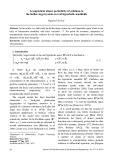


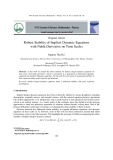

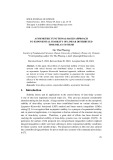
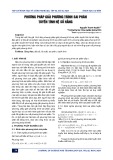
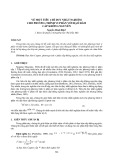
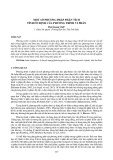















![Quyển ghi Xác suất và Thống kê [chuẩn nhất]](https://cdn.tailieu.vn/images/document/thumbnail/2025/20251030/anh26012006/135x160/68811762164229.jpg)
